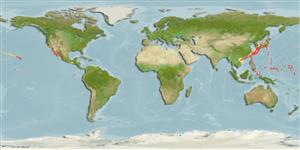Common names from other countries
Environment: milieu / climate zone / depth range / distribution range
Écologie
marin benthopélagique; profondeur 100 - 400 m (Ref. 58302). Subtropical
Pacific Ocean: Japan, Okinawa, Korea, and the Hawaiian Islands.
Taille / Poids / Âge
Maturity: Lm ? range ? - ? cm
Max length : 21.7 cm SL mâle / non sexé; (Ref. 6180)
Collected up to 280 m deep, over rocky bottom. May occur in shallower waters of Japan (Ref. 6180).
Life cycle and mating behavior
Maturities | Reproduction | Spawnings | Egg(s) | Fecundities | Larves
Randall, J.E. and L. Taylor, 1988. Review of the Indo-Pacific fishes of the serranid genus Liopropoma, with descriptions of seven new species. Indo-Pac. Fish. (16):47 p. (Ref. 6180)
Statut dans la liste rouge de l'IUCN (Ref. 130435)
CITES (Ref. 128078)
Not Evaluated
Menace pour l'homme
Harmless
Utilisations par l'homme
Outils
Articles particuliers
Télécharger en XML
Sources Internet
Estimates based on models
Preferred temperature (Ref.
115969): 5.9 - 21.3, mean 15.4 (based on 99 cells).
Phylogenetic diversity index (Ref.
82804): PD
50 = 0.5000 [Uniqueness, from 0.5 = low to 2.0 = high].
Bayesian length-weight: a=0.01122 (0.00514 - 0.02450), b=3.04 (2.87 - 3.21), in cm Total Length, based on all LWR estimates for this body shape (Ref.
93245).
Niveau trophique (Ref.
69278): 4.1 ±0.7 se; based on size and trophs of closest relatives
Fishing Vulnerability (Ref.
59153): Low vulnerability (16 of 100).
